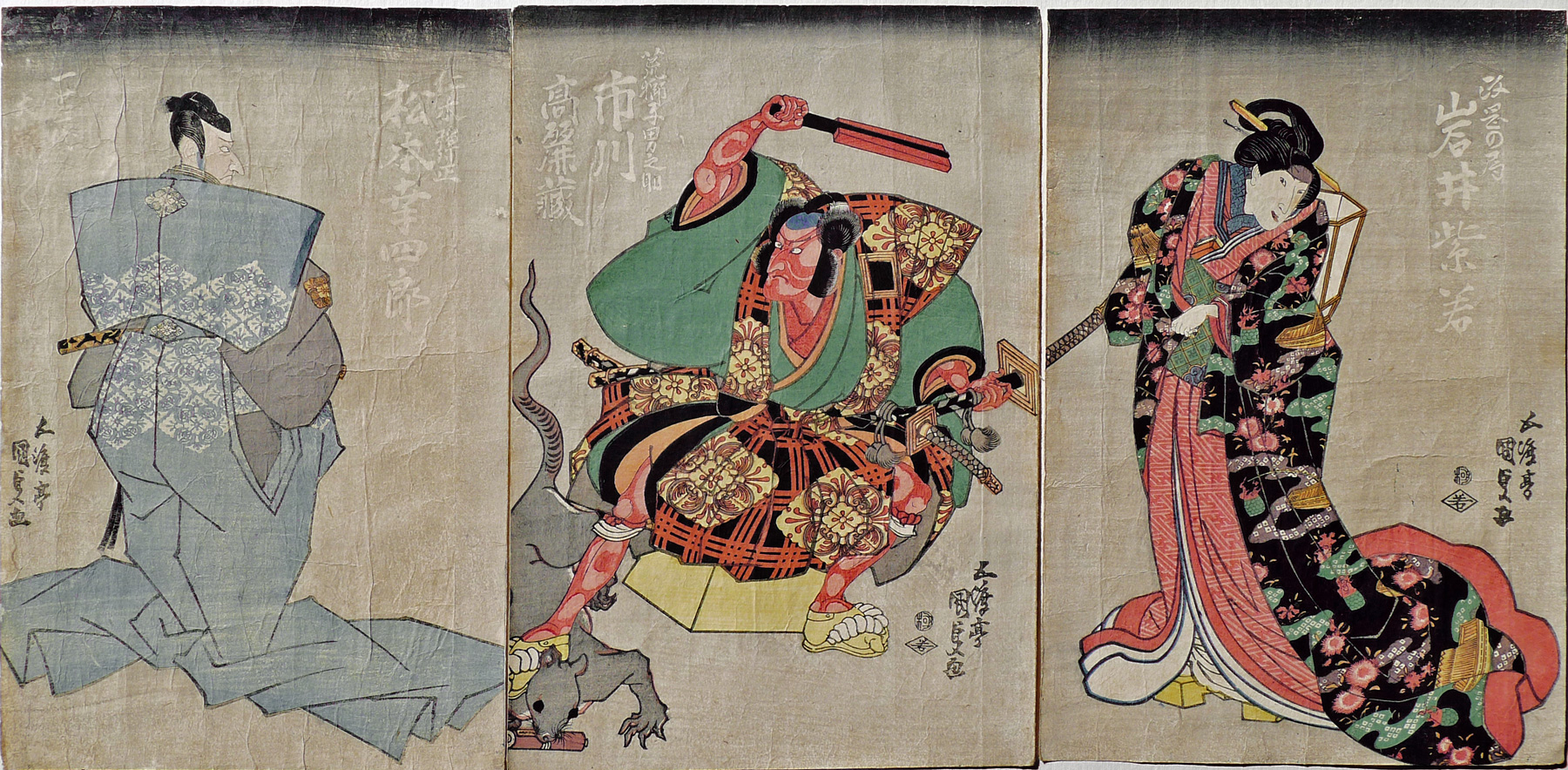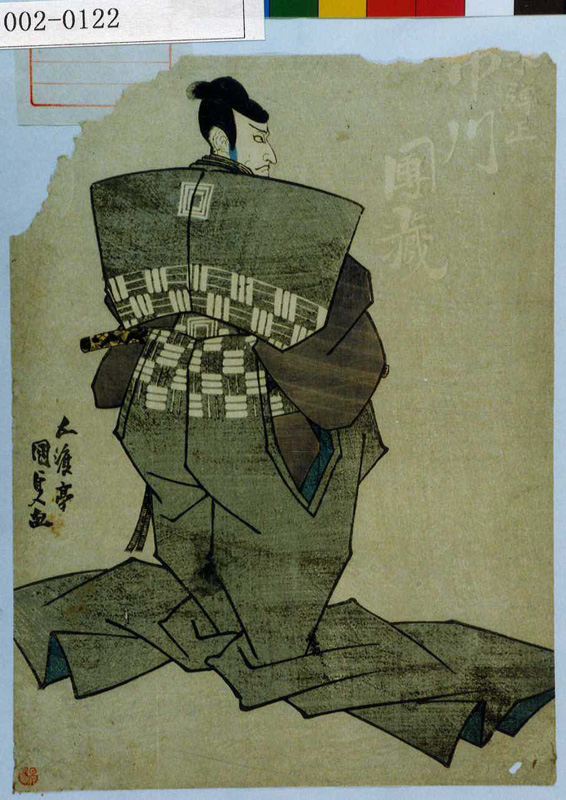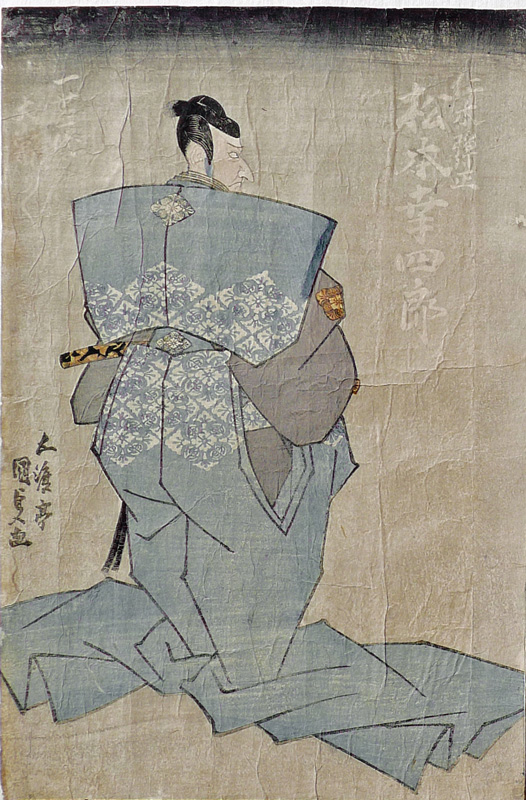About This Print
From right to left, the actors Iwai Shijaku (岩井紫若) as Masaoka no Tsubone ( 政岡の局), Ichikawa Komazō V (市川高麗蔵) as Arajishi Otokonosuke (獅子男之助)and, Matsumoto Kōshirō V (松本幸四郎) as Nikki Danjō (仁木弾正) in the play Date Kurabe Okuni Kabuki (伊達競阿國劇場). It is unclear whether the three prints constitute a triptych as the left panel does not visually match with the center panel, although one does expect to see the evil Nikki Danjō (left panel) next to his true rat (子) form (center panel). The center panel, which depicts the character Otokonosuke striking Nikki Danjō's rat self with his iron battle fan in the scene Yukashita no ba (Scene under the floor), does visually match with the right panel depicting the character Masaoka no Tsubone, giving us at least a diptych as issued by the publisher.Each panel of the triptych contains the names and roles of the actors to the right of their figures and the left panel also contains an inscription to the left of the actor reading 一世一代 當々 (isse ichidai, ōatari ōatari) meaning "Once in a lifetime performance, big hit, big hit!"1
| Utagawa Kunisada I, Ichikawa Danzō V (市川団蔵) as Nikki Danjō (仁木弾正), 1839 The Tsubouchi Memorial Theatre Museum Digital Archives Collection, Waseda University Library 002-0122 | Utagawa Kunisada I, Matsumoto Kōshirō V (松本幸四郎) as Nikki Danjō (仁木弾正), 1836 IHL Cat. #953 |
The Play Date Kurabe Okuni Kabuki
Source: Kabuki Plays On-Stage: Villainy and Vengeance, 1773-1799, ed. James R. Brandon, Samuel L. Leiter, University of Hawaii Press, 2003, sections extracted from pages 50-72.Meiboku Sendai Hagi (The Precious Incense and Autumn Flowers of Sendai) and its derivative play Date Kurabe Okuni Kabuki (The Date Rivalry and Okuni Kabuki)
While people often like to describe kabuki as having beenperformed in the same way for hundreds of years, this rarely has been thecase. Plays changed with eachperformance as different actors assumed the roles and fans expected somethingnew.... Over the course of two centuriesof adaptations, not only were new scenes added to The Precious Incense and Autumn Flowers of Sendai, but the storywas almost completely altered from its original form. Through all these changes, Precious Incense has proved to be one ofthe durable of kabuki classics, having had, with few exceptions, at least oneperformance annually since its premiere in 1777.
Precious Incensedramatizes historical events – an attempted coup, in 1660, by retainers of theDate household and the gallant efforts of loyal retainers to thwart the coup. The scandal caused a sensation in itsday. Some earlier plays had dealt withthe subject, but the first to bear the title Meiboku Sendai Hagi was staged in 1777 at Osaka’s Naka noShibai. It is usually considered to havebeen the play’s “first” performance. Thefollowing year saw Sakurada Jisuke I’s (1734-1806) The Date Rivalry and Okuni Kabuki (Date Kurabe Okuni Kabuki)produced at Edo’s Nakamura-za. Thepopularity of these two works led to a 1785 adaptation by Matsu Kanshi andothers for the puppet theatre, which used the title Meiboku Sendai Hagi, and this was then reimported back into kabuki,where the play’s development continued through the nineteenth century.
The play’s continuing popularity is undoubtedly due to thefascinating role of Masaoka. Shedemonstrates unwavering loyalty even as she watches her own child killed beforeher eyes, an act she must endure with supreme stoicism. Masaoka is considered the greatest and mostdifficult of all kabuki roles for a female-role specialist (onnagata).
Because of the strength of Masaoka’s character, the actorplaying the evil Nikki Danjō must be ofthe highest artistic standing in order to share the stage with her. The kata1 for Danjō go back even earlier than do Masaoka’s, to Matsumoto Kōshirō V (1764-1838). Actors today will even go so far as to placea mole on their forehead, imitating Kōshirō’s, as homage to his masterfulperformance.
The Scene Under the Floor (Yukashita no ba)2
(The entire roomrises, revealing supporting wooden pillar underneath. STAGE ASSISTANTS remove a red cloth to reveal ARAJISHI OTOKONOSUKE TERUHIDE, an exaggeratedly powerful [aragoto] samurai, rising from the enter lift to rapidtsuke beats. He wears a green kimono with red trim and black and gold formalover-wear [kamishimo]. His face and limbs are red with bold red,white, and black stylized makeup [kumadori], all expressing his youthful strength. He is seated with one leg holding down a rat, played now by a small,acrobatic actor in a rat costume [nuigurumi]. Heholds a fan above his head in his right hand and his sword hilt ready in hisleft. Ki.)
OTOKONOSUKE: How strange. (Turning the sword hilt, he performs a mie to two tsuke beats.) I, Arajishi Otokonosuke Teruhide, have beenbanished from my lord’s presence because of the lies of evil men, but I haveset up camp here under his bedroom. Now,from out of nowhere, comes this rat. Ican tell it is no ordinary rat. (Mie to two tsukebeats.) Give up that scroll and disappear before I stuff this iron fan downyour throat.
(Spitting on his handand snorting, he again poses to two tsuke beats with fan lifted. During a brief combat [tachimawari] OTOKONOSUKE fights the rat with large, slow, stylizedmovements. He swings his fan at the rattwice, once down to the left, once down to the right in the “mountain” pattern [yamagata]. Heflips the rat and kicks it back. Eachmovement is emphasized by tsuke aswell as loud beats of the offstage drum. He hits the rat on its forehead with his fan. The rat spins quickly on one knee and then crossesto shichisan, where it disappearsdown the open elevator trap [sappon]. To the sound of fast dorodoro drumbeats indicating the supernatural,smoke billows from the trap as NIKKIDANJŌ – the rat in human form – rises onit, holding a scroll in his mouth and forming a spell with his fingers. His grey formal garb and kimono echo hisearlier grey rat costume. His trailing hakama [nagabakama] must be carefully manipulated as he walks. A crescent-shaped wound scars his foreheadwhere the rat was hit on the head with the fan.)
1 In kabuki a set of stylized forms designed for one specific role and transmitted from generation to generation.The Actors Pictured in This Collection's Print
For profiles of the actors depicted in this print please see the article The Kabuki Actor.Print Details
| IHL Catalog | #953 |
| Title | Actors Iwai Shijaku (岩井紫若) as Masaoka no Tsubone ( 政岡の局), Ichikawa Komazō V (市川高麗蔵) as Arajishi Otokonosuke (獅子男之助)and, Matsumoto Kōshirō V (松本幸四郎) as Nikki Danjō (仁木弾正) [in the play Date Kurabe Okuni Kabuki伊達競阿國劇場] |
| Series | n/a |
| Artist | Utagawa Kunisada I (1786–1865) |
| Signature |  [Gototei[五渡亭] was Kunisada's most common gō (artist name) until 1844. Itliterally means "Pavillion of the Fifth Ferry" and refers to theferry boat service owned by Kunisada's family.] Source: http://www.kunisada.de/Liste/kunisada-signature-seal.html |
| Seal | no artist seal present |
| Publication Date | 1836 天保07 (Date is taken from the Tokyo Metropolitan Library database entries for the right and center panels. Date for the right panel is unknown.) |
| Publisher |  Publisher's seal appears on right and center panels only |
| Carver | unknown |
| Impression | excellent |
| Colors | excellent |
| Condition | fair - extensive wrinkling throughout; remnants of backing paper; repairs verso to left panel |
| Genre | ukiyo-e; yakusha-e |
| Miscellaneous |  |
| Format | oban triptych |
| H x W Paper | 14 1/4 x 9 3/4 (36.2 x 24.8 cm) each sheet |
| Collections This Print | Tokyo Metropolitan Library archive N074-019 right panel only; Japan Arts Council 04004 center panel only |
| Reference Literature | |




